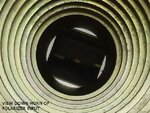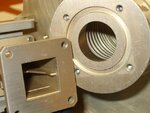Darktrax
Full Member level 5
Our supplied 8GHz corrugated horn has a round exit hole, and is bolted directly onto the square aperture of a septum-type polarizer. This separates the RHCP and LHCP into two normal rectangular waveguides
The diameter of the hole is somewhat larger than the size of the square sides, and also somewhat smaller than the diagonal. Looking down the horn, one can see the four sides showing some flange face protruding into the circular guide. From the other side, it is the corners that are cut off by the circle.
I have been told by a engineer that it is common to just bolt them together.
This does not sit easy with me. I might have more readily agreed if the hole had been smaller than the rectangle everywhere. Somehow, when even small things that poke into guides are critical, this seems unreasonable, but I don't know.
So the question.. does this really matter much?
As it happens, I am looking for the cause of about 2 dB of losses, and I don't want to be spinning my wheels going after something that is not actually the problem.
Info: Square is 23.76mm (0.935in) side, and hole is 26.8mm (1.05in) dia.
The diameter of the hole is somewhat larger than the size of the square sides, and also somewhat smaller than the diagonal. Looking down the horn, one can see the four sides showing some flange face protruding into the circular guide. From the other side, it is the corners that are cut off by the circle.
I have been told by a engineer that it is common to just bolt them together.
This does not sit easy with me. I might have more readily agreed if the hole had been smaller than the rectangle everywhere. Somehow, when even small things that poke into guides are critical, this seems unreasonable, but I don't know.
So the question.. does this really matter much?
As it happens, I am looking for the cause of about 2 dB of losses, and I don't want to be spinning my wheels going after something that is not actually the problem.
Info: Square is 23.76mm (0.935in) side, and hole is 26.8mm (1.05in) dia.

